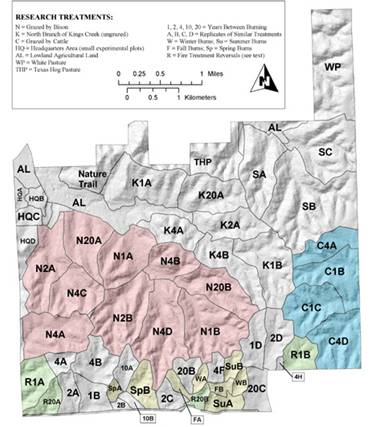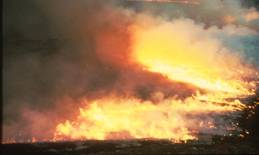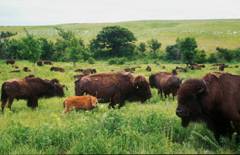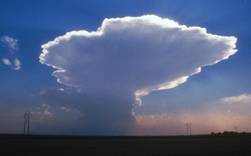|
|
KNZ Core Research Areas
The Konza LTER program continues to build upon a long-term database on ecological
patterns and processes derived from a fully replicated watershed-level experimental
design, in place since 1977 (Fig. 1). This design includes replicate watersheds
subject to different fire and grazing treatments, as well as a number of long-term
plot-level experiments (Table 1). The effects of climate are addressed by long-term
studies encompassing the natural climatic variability, and possible directional
changes, characteristic of this region, as well as manipulations of water availability
in field experiments. Within core LTER watersheds, permanent sampling transects
are replicated at various topographic positions (n=4/topo. position/watershed),
where ANPP, plant species composition, plant and consumer populations, soil
properties, and key above- and belowground processes are measured. The collection
of diverse data from common sampling locations facilitates integration among
our research groups. In total, the Konza LTER Program incorporates explicit
study of the major factors influencing mesic grasslands in a long-term experimental
setting. It has the essential components of a statistically rigorous ecological
research program designed to elucidate patterns and processes inherently important
in grasslands, and address the potential impacts of global change in these ecosystems.
Below we elaborate on our rationale for focusing on fire, grazing and climate,
and describe our core LTER experiments.
 Fig.
1. Konza Prairie site experimental design, and watershed-level fire and grazing
treatments. Watersheds open to bison grazing (‘N’) are highlighted
in red, and cattle-grazed watersheds (‘C’) are highlighted in blue.
All other watersheds are ungrazed. Numbers in watershed codes designate fire
return intervals for spring-burned watersheds, and the last letter of watershed
codes (A,B,C,D) is used to identify replicate watersheds of the same treatment.
Watersheds subject to different seasons of burn are highlighted in yellow, and
the Fire Treatment Reversal (‘R’) watersheds are highlighted green.
Many of our plot-level experiments (Belowground Experimental Plots, RaMPs, Irrigation
Transects) are located at the headquarters area (HQ) in the northwest portion
of the site. Fig.
1. Konza Prairie site experimental design, and watershed-level fire and grazing
treatments. Watersheds open to bison grazing (‘N’) are highlighted
in red, and cattle-grazed watersheds (‘C’) are highlighted in blue.
All other watersheds are ungrazed. Numbers in watershed codes designate fire
return intervals for spring-burned watersheds, and the last letter of watershed
codes (A,B,C,D) is used to identify replicate watersheds of the same treatment.
Watersheds subject to different seasons of burn are highlighted in yellow, and
the Fire Treatment Reversal (‘R’) watersheds are highlighted green.
Many of our plot-level experiments (Belowground Experimental Plots, RaMPs, Irrigation
Transects) are located at the headquarters area (HQ) in the northwest portion
of the site.
Table 1. Brief description of selected long-term, plot-level experiments of
the Konza LTER program. Such experiments complement our long-term watershed-scale
studies, and provide important information about mechanisms underlying responses
at broader scales. These experiments also act as focal points for ecological
studies that span multiple disciplines.
| Experiment
and Year Initiated |
Treatments |
Main
Response Variables |
| Belowground
Plot Experiment (1986)
|
Burning,
mowing and nutrient (N, P) additions; 5´5m
plots
|
ANPP,
BNPP, plant species composition, plant N and P content, decomposition,
soil chemistry, soil biota |
| Rainfall
Manipulation Plots (RaMPs) (1997)
|
Timing
and amount of ppt; increased temperature treatment to be added for LTER
V |
ANPP,
BNPP, plant species composition, plant ecophysiology, decomposition, soil
C and N flux, soil biota
|
| Irrigation
Transect (1991)
|
Growing
season water additions, upland and lowlands; new N treatment added in
1999 |
ANPP,
plant species composition, plant N content, BNPP, decomposition, soil
C and N flux, soil biota |
| P
Addition Experiment (new for LTER V)
|
P
added at 4 rates, +/- N to assess relative N and P limitation |
ANPP,
species composition, mycorrhizal colonization levels, soil N and P fractions |
| Grasshopper
Removal
Experiment
(new for LTER V)
|
Grasshopper
reductions from plots in 1-yr and 4-yr burn wuplands, +/- bison |
ANPP,
plant species composition, plant C/N content, N cycling processes, decomposition,
insect communities |
Fire Fire is essential in mesic grasslands worldwide, and human alteration of
fire frequency is a key element of global change in these grasslands. Fire was
important historically in tallgrass prairie,  and
is now managed by humans to limit the growth of woody plants and to promote the
cover and productivity of C4 grasses. Fire alters the structure and function of
grasslands, and our studies of the ecological consequences of fire have spanned
multiple spatial and temporal scales and levels of ecological study. This hierarchical
approach has identified many of the mechanisms contributing to responses at higher
levels. For example, fire changes the light and soil environment of emerging plants,
altering phenology and physiological responses, increasing ANPP, increasing competition for light and N. These changes contribute to reduced abundance and richness of C3 plants and a concomitant decline in biodiversity. Changes in vegetation structure,composition and tissue quality also elicit responses in aboveground consumers and affect belowground invertebrates, mycorrhizae and soil microbes. and
is now managed by humans to limit the growth of woody plants and to promote the
cover and productivity of C4 grasses. Fire alters the structure and function of
grasslands, and our studies of the ecological consequences of fire have spanned
multiple spatial and temporal scales and levels of ecological study. This hierarchical
approach has identified many of the mechanisms contributing to responses at higher
levels. For example, fire changes the light and soil environment of emerging plants,
altering phenology and physiological responses, increasing ANPP, increasing competition for light and N. These changes contribute to reduced abundance and richness of C3 plants and a concomitant decline in biodiversity. Changes in vegetation structure,composition and tissue quality also elicit responses in aboveground consumers and affect belowground invertebrates, mycorrhizae and soil microbes.
The experimental design at Konza (Fig. 1) includes replicate watersheds (avg.
size = 60 ha) that, since 1972, have been burned annually or at 2-, 4-, 10- and
20-year frequencies, encompassing a range of likely natural fire frequencies and
management extremes. Most watersheds are burned at the end of the dormant season
(April), when the greatest frequency of lightning and prescribed burning occurs
regionally. However, fires historically occurred at other times, and during LTER
IV we initiated a “season of fire” experiment, with replicate watersheds
burned in the spring, summer, fall or winter. To address trajectories following
a change in fire regime and the role of fire history (legacy effects), we began
(in 2001) a long-term “fire treatment reversal” experiment (annual
and 20 yr fire treatments switched on replicate watersheds). This new experiment
will provide insights into the temporal scales over which plant and soil processes
respond to changing fire regimes, and the role of site history in affecting responses
to fire. We also incorporate fire into smaller plot-scale plot experiments on
Konza, where mechanisms underlying effects of fire are more readily addressed.
Grazing Grazing, like fire, was historically important in tallgrass prairie,
but is now largely under human control, with grazing by cattle the dominant
land use in the Flint Hills.  In
fact, changes associated with the management of megaherbivores are among the
most significant in the recent history of mesic grasslands worldwide. Understanding
the role of grazers in these grasslands is crucial, To address the role of native
grazers and important fire ? grazing interactions, bison were reintroduced in
1987 to a 1000-ha area of Konza that includes replicate watersheds burned at
1-, 2-, 4- and 20-year intervals and a range of topography and vegetation types.
Comparative studies of native (bison) vs. introduced (cattle) ungulates are
also needed to understand the impacts of changing land use in North American
grasslands. Functional similarities and differences in the effects of bison
and cattle on grasslands are being assessed by long-term comparisons of bison
and cattle grazing at both the watershed and small enclosure (5 ha) scales. In
fact, changes associated with the management of megaherbivores are among the
most significant in the recent history of mesic grasslands worldwide. Understanding
the role of grazers in these grasslands is crucial, To address the role of native
grazers and important fire ? grazing interactions, bison were reintroduced in
1987 to a 1000-ha area of Konza that includes replicate watersheds burned at
1-, 2-, 4- and 20-year intervals and a range of topography and vegetation types.
Comparative studies of native (bison) vs. introduced (cattle) ungulates are
also needed to understand the impacts of changing land use in North American
grasslands. Functional similarities and differences in the effects of bison
and cattle on grasslands are being assessed by long-term comparisons of bison
and cattle grazing at both the watershed and small enclosure (5 ha) scales.
Climate North American grasslands were formed by climate changes originating
during the Miocene-Pliocene transition, and their present day distributions
depend on regional temperature and precipitation gradients. Although our emphasis
on fire and grazing interactions is clearly appropriate,  and
unique within the LTER network, >20 yrs of study has underscored the pervasive
role of interannual climatic variability in this ecosystem. For mesic grasslands,
the mean and extremes of precipitation (e.g., floods and droughts) affect most
ecosystem processes. On a continental scale, variability in precipitation affects
productivity more in grasslands than in other North American biomes. Thus, responses
to altered temperature and precipitation regimes will be an important component
of global change. Climate change predictions for the Central Plains include
increased temperatures and increased temporal variability in rainfall (i.e.,
larger storm events and longer intervening dry periods. Changes in temporal
patterns of precipitation are predicted impact grasslands more than changes
in precipitation quantity alone. We are just beginning to understand how grasslands
will respond to more extreme rainfall patterns. Longer-term studies, and those
considering multiple, interacting factors (i.e., temperature and precipitation)
are needed. New experiments for LTER V are assessing grassland responses to
climate change over short- and long- time scales. and
unique within the LTER network, >20 yrs of study has underscored the pervasive
role of interannual climatic variability in this ecosystem. For mesic grasslands,
the mean and extremes of precipitation (e.g., floods and droughts) affect most
ecosystem processes. On a continental scale, variability in precipitation affects
productivity more in grasslands than in other North American biomes. Thus, responses
to altered temperature and precipitation regimes will be an important component
of global change. Climate change predictions for the Central Plains include
increased temperatures and increased temporal variability in rainfall (i.e.,
larger storm events and longer intervening dry periods. Changes in temporal
patterns of precipitation are predicted impact grasslands more than changes
in precipitation quantity alone. We are just beginning to understand how grasslands
will respond to more extreme rainfall patterns. Longer-term studies, and those
considering multiple, interacting factors (i.e., temperature and precipitation)
are needed. New experiments for LTER V are assessing grassland responses to
climate change over short- and long- time scales.
|